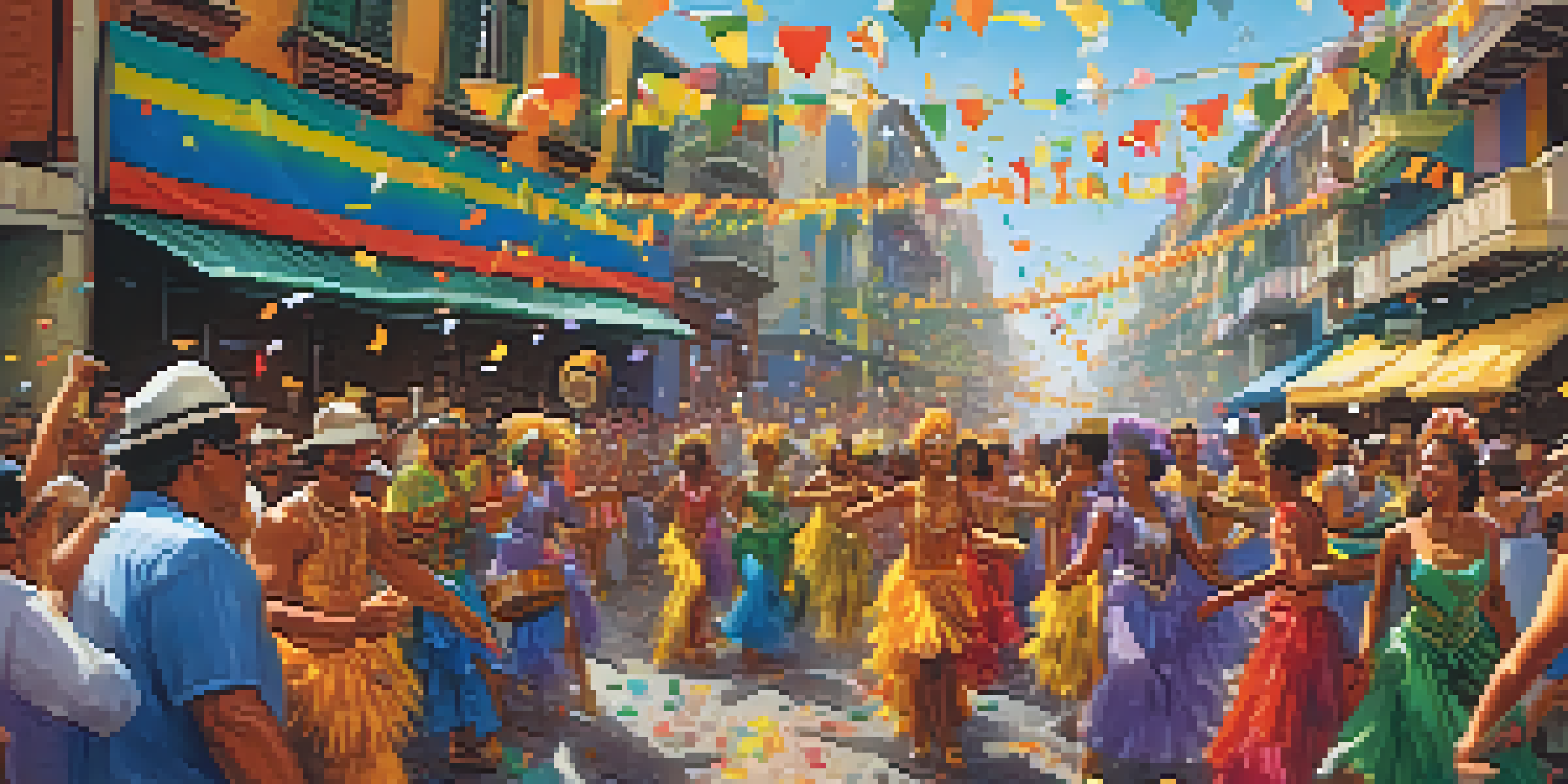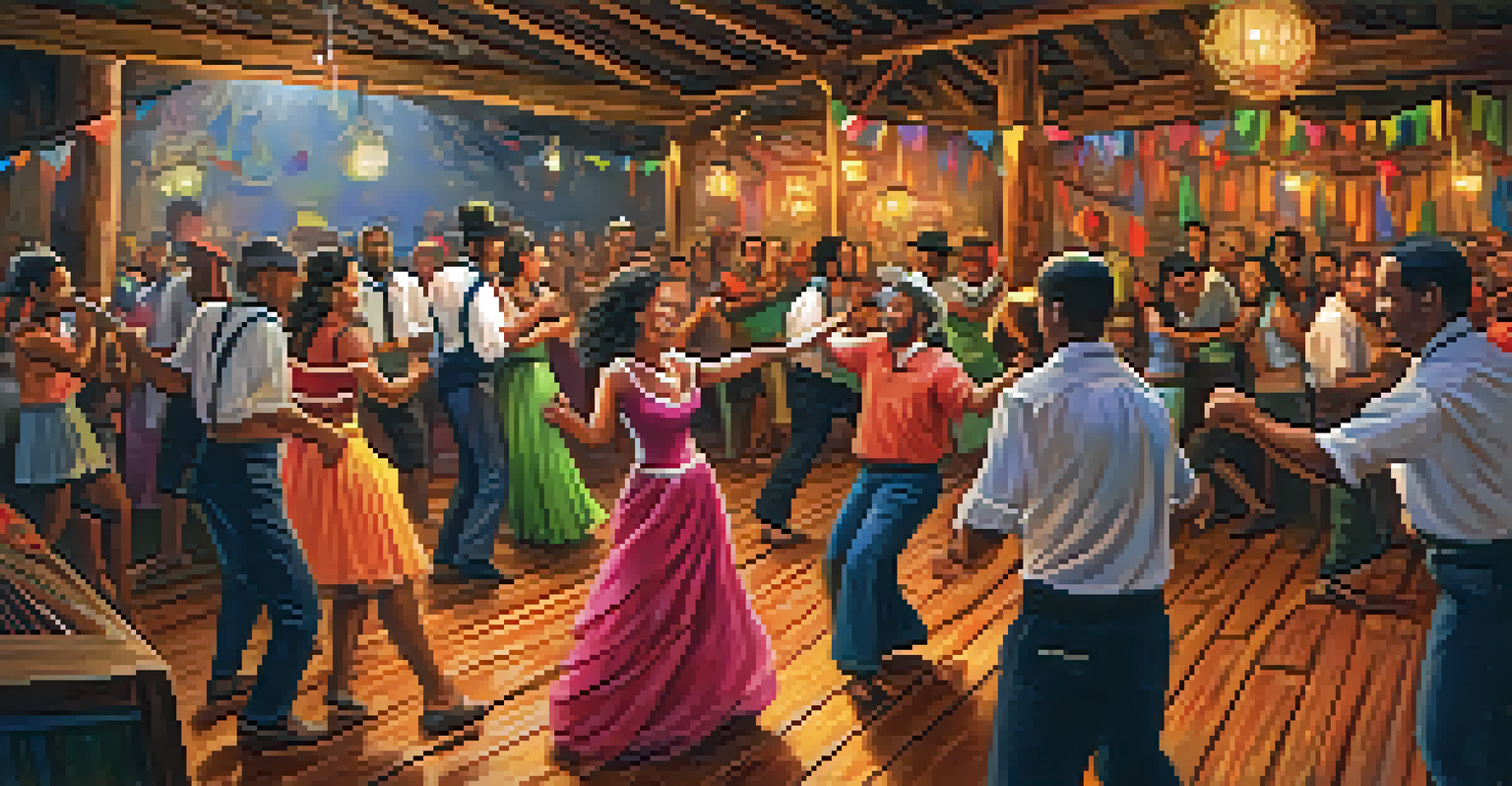Brazilian Music: A Journey Through Rhythms and Sounds

The Heartbeat of Brazil: Understanding Its Musical Roots
Brazilian music is a vibrant tapestry woven from a variety of cultural influences. At its core, it reflects the country's rich history, blending Indigenous, African, and European musical traditions. This fusion creates a unique soundscape that resonates with the spirit of Brazil, making its music an essential part of everyday life.
Music is the universal language of mankind.
From the rhythmic beats of the samba to the intricate melodies of bossa nova, each genre tells a story rooted in the country's diverse heritage. For instance, samba, which originated in the Afro-Brazilian communities, is not just a music style; it’s a symbol of joy, celebration, and cultural identity. Understanding these roots helps us appreciate the deep emotional connection Brazilians have with their music.
As we delve deeper into Brazilian music, we'll uncover how these various forms have evolved and influenced one another, creating a dynamic sound that continues to captivate audiences worldwide. This exploration will take us on a journey through Brazil's rich musical landscape.
Samba: The Rhythm of Celebration and Community
Samba is arguably the most iconic genre of Brazilian music, synonymous with Carnival and vibrant street parties. Originating in the early 20th century, this lively rhythm has roots in African musical traditions brought to Brazil by enslaved people. Today, samba is celebrated not just for its infectious beats but also for its ability to bring people together, fostering a sense of community.

During Carnival, samba schools compete in elaborate parades, showcasing their intricate costumes, choreography, and of course, their music. Each performance tells a story, often reflecting social issues or historical events, making samba a powerful medium for expression. This fusion of entertainment and social commentary is part of what makes samba so special.
Brazilian Music's Rich Heritage
Brazilian music is a vibrant fusion of Indigenous, African, and European influences that reflects the country's diverse cultural history.
Beyond the parades, samba has found its way into everyday life in Brazil. From backyard gatherings to local bars, the rhythm of samba continues to echo in the hearts of many, proving that this genre is more than just music—it's a celebration of life itself.
Bossa Nova: A Smooth Fusion of Jazz and Samba
Bossa nova, which translates to 'new trend,' emerged in the late 1950s and quickly became a global sensation. It combines the rhythmic elements of samba with the sophistication of jazz, creating a smooth and laid-back sound that is both soothing and complex. Pioneered by artists like João Gilberto and Tom Jobim, bossa nova has left an indelible mark on the music world.
Where words fail, music speaks.
This genre often features soft guitar strumming, gentle melodies, and poetic lyrics that reflect a sense of longing and nostalgia. Songs like 'The Girl from Ipanema' exemplify the bossa nova style, capturing the beauty of Brazilian beaches while evoking deep emotional connections. It’s this blend of simplicity and depth that makes bossa nova so enchanting.
As bossa nova gained popularity, it also influenced countless musicians outside of Brazil, bridging cultural divides and showcasing the universal language of music. Today, you can find bossa nova rhythms in jazz clubs, cafes, and even pop music, proving that its legacy lives on.
Forró: The Danceable Sound of Northeastern Brazil
Forró is a lively and energetic genre that hails from the northeastern region of Brazil. Characterized by its accordion, zabumba (a type of drum), and triangle, forró is not just music—it's a dance that brings people together in joyous celebration. Its infectious rhythm invites everyone to the dance floor, making it a staple at parties and festivals across Brazil.
The roots of forró can be traced back to the traditional folk music of the region, but it has evolved over time, incorporating influences from other genres. Songs often tell stories of love, hardship, and daily life, resonating with audiences on a personal level. The communal aspect of forró dances fosters a sense of belonging and camaraderie among participants, further enhancing its appeal.
Samba Unites Through Celebration
Samba is not just music but a powerful cultural expression that fosters community and joy, particularly during Carnival festivities.
With its upbeat tempo and engaging melodies, forró has become increasingly popular beyond Brazil's borders. The genre's accessibility and lively spirit make it an excellent way for people to connect and celebrate, embodying the heart of Brazilian culture in every beat.
MPB (Música Popular Brasileira): A Musical Melting Pot
Música Popular Brasileira, or MPB, emerged in the 1960s as a response to Brazil's social and political climate. It blends traditional Brazilian music with international influences, resulting in a rich and diverse sound. Artists like Caetano Veloso and Gilberto Gil are pioneers of this genre, often using their music as a platform for social commentary and artistic expression.
MPB is characterized by its eclectic mix of styles, incorporating elements from rock, jazz, and folk music. This genre encourages experimentation and innovation, allowing artists to push the boundaries of traditional Brazilian music. As a result, MPB has produced some of the most profound and thought-provoking songs in Brazil's musical history.
The influence of MPB extends far beyond its borders, inspiring musicians around the world. Its ability to address complex themes through accessible melodies makes it a powerful tool for cultural exchange, inviting listeners to explore the rich tapestry of Brazilian life through sound.
Axé: The Energetic Sound of Bahia
Originating from the vibrant state of Bahia, Axé music is a lively and upbeat genre that combines Afro-Brazilian rhythms with pop influences. It first gained popularity in the 1980s and quickly became a staple during Carnival celebrations in Bahia. With its catchy melodies and danceable beats, Axé music creates an electrifying atmosphere that encapsulates the joy of Brazilian festivities.
Artists like Ivete Sangalo and Gilberto Gil have played a significant role in popularizing Axé, bringing its infectious energy to audiences far and wide. The music often features themes of love, celebration, and social issues, making it relatable to many. Axé’s powerful rhythms encourage people to dance, fostering a sense of unity and shared experience among listeners.
Future of Music: Tradition Meets Innovation
The evolution of Brazilian music continues as artists blend traditional rhythms with modern genres, ensuring its relevance and global appeal.
As Axé continues to evolve, it remains a symbol of Bahian culture and spirit. The genre's ability to bring people together in celebration highlights the importance of music in fostering community and connection, showcasing the heart of Brazil's vibrant culture.
The Global Influence of Brazilian Music
Brazilian music has transcended borders, influencing artists and genres worldwide. From the smooth sounds of bossa nova to the infectious rhythms of samba, these musical styles have found their way into the hearts of many across the globe. Artists like Sergio Mendes and Astrud Gilberto have played a crucial role in introducing Brazilian music to international audiences, blending it with various musical traditions.
The cross-pollination of musical styles has led to exciting collaborations and innovations, showcasing the versatility and richness of Brazilian music. For example, the fusion of samba with hip-hop has created a fresh sound that resonates with younger generations, proving that Brazilian music continues to evolve while maintaining its cultural roots.

As we celebrate the global influence of Brazilian music, it's essential to recognize the power of music as a universal language. It connects people from all walks of life, reminding us that, no matter our differences, we can find common ground through the rhythms and sounds that bring us together.
The Future of Brazilian Music: Innovation and Tradition
The future of Brazilian music is bright, as artists continue to explore new sounds while honoring their cultural heritage. With the rise of digital platforms, musicians have unprecedented access to global audiences, allowing them to share their unique voices and stories. This fusion of tradition and innovation creates a fertile ground for creativity and artistic expression.
Emerging genres, such as trap and electronic music, are being infused with Brazilian rhythms, creating a new wave of sounds that reflect contemporary life. Artists like Anitta and Alok are leading the charge, blending traditional influences with modern beats to reach a diverse audience. This evolution showcases the adaptability of Brazilian music while remaining rooted in its rich history.
As we look ahead, the continued exploration of Brazilian music promises to captivate hearts and minds, both in Brazil and around the world. By embracing innovation while respecting tradition, Brazilian artists are ensuring that their music will thrive for generations to come, inviting everyone to join in this ever-evolving journey through rhythms and sounds.